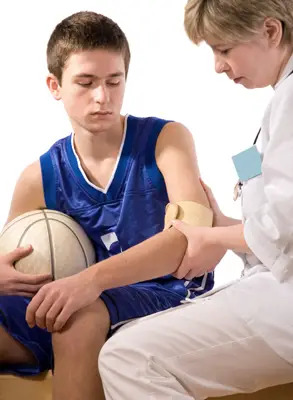 With children’s sports-related injuries continuing to rise nationwide to more than 3.5 million annually, keeping kids healthy is a top priority for parents, schools and sports leagues.
With children’s sports-related injuries continuing to rise nationwide to more than 3.5 million annually, keeping kids healthy is a top priority for parents, schools and sports leagues.
Despite the plethora of protective gear kids now wear for practices or games, their developing bodies are still vulnerable to injury.
The good news is that there are many different things parents and coaches can do to help kids stay safer on the field or court.
Soft Tissues
“The majority of sports-related injuries involve the body’s soft tissues rather than the bones,” says Dr. Teri McCambridge, chair of the American Academy of Pediatrics (AAP) Council on Sports Medicine & Fitness. “That’s why it’s important that children avoid overuse or strain.”
In fact, an epidemic of recurrent elbow pain from overuse led Little League Baseball, Inc., to limit pitchers under the age of 13 to six innings per week; 13- to 16-year-olds are allowed to pitch a maximum of nine innings. Since then, the incidence of recurrent elbow pain has decreased dramatically.
You can also prevent injuries by encouraging young athletes to train for their sport, rather than rely on the sport to whip them into shape. Proper physical conditioning can go a long way toward keeping players off the disabled list and on top of their game. Ask your teen’s coach to help design a suitable exercise regimen.
Hard Headed
Head injuries don’t just happen to football players. Sports like soccer, baseball and even basketball can lead to head injuries if proper precautions aren’t taken.
According to a 2010 study published in the journal “Pediatrics,” young athletes are more susceptible to the effects of concussions because their brains are still developing. Ways to reduce risk include using protective gear, adhering to the rules of the sport, identifying athletes at risk, and educating parents, athletes and coaches about concussion dangers.
The AAP recommends that all children who suffer a concussion be evaluated by a physician and rest physically and mentally — that means no television, video games or homework. Most symptoms resolve in 7 to 10 days, but some may take up to a month to disappear.
Return to Play
Medical clearance is necessary before returning to play after any injury, but especially after head injuries. Athletes who suffer multiple concussions or post-concussive symptoms for more than three months should consider retiring from competitive sports.
Parents and coaches should also make sure to identify the cause of any injury before allowing a child to return to play. Was the child using the right safety equipment? Was the field in bad shape? Was the exercise regime too strenuous or poorly managed? Neglecting these factors is a sure path to repeat injuries.
For more information on preventing sports injuries, visit the AAP website, www.healthychildren.org.
By preventing common sports injuries, you can ensure your child enjoys an active life for many years to come.
Courtesy of StatePoint Media
Also see: How to Spot an Overuse Injury
How to Know When a Head Injury is Serious



















